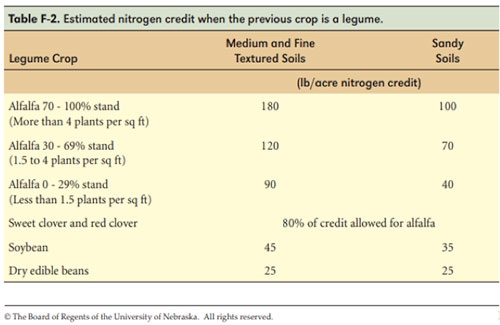You are here
Home ›What's Up at the USDA Office?

Table F-2. Submitted graphic.
Upcoming Deadlines/Dates
November 25: Office closed in observance of Thanksgiving
December 6: Deadline to Return COC Ballots
December 15: Fall Seeded Crop Certification Deadline
March 15: ARCPLC Program Deadline
Taking N Credits for Legumes, Manure and Cover Crops
by LuAnn Rolling, NRCS District Conservationist
All indicators are that fertilizer costs are going to be much higher for the 2022 crop season. Producers are going to have to take a hard look at their fertility program and try to take credit for all nitrogen fertilizer sources, including legumes, manure, and cover crops. Legumes fix nitrogen from the air and store it in root nodules. This nitrogen becomes available when the plant dies and decays. When legumes die, their residue is easily broken down by microorganisms that release nitrogen back into the soil. The result is a net increase of nitrogen in the soil system because much of the nitrogen released from the decaying plant was not obtained from existing nitrogen in the soil. Simply put, the legume took nitrogen from the air and put it into the soil.
The amount legumes actually fix depends on the amount of nitrogen in the soil. The legumes will use the available soil nitrogen first before they fix enough nitrogen to meet the rest of their needs. This is why soil nitrates are usually low following a legume crop. According to research from the University of Nebraska Lincoln, UNL, on medium and fine textured soils a good stand of alfalfa (more than 4 plants per sq. ft.) you can take up to 180 lb/ac nitrogen credit and a poor stand 90 lb/acre. For sweet and red clover take 80% of the credit allowed for alfalfa. Table F-2 shows the expected nitrogen credit when a grain crop follows a legume.
When it comes to taking soybean nitrogen credit Ron Gelderman, former Professor and South Dakota State University, SDSU, Extension Soils Specialist, says we have all been programmed to think of soybean as fixing nitrogen from the atmosphere and adding nitrogen to the soil. He cites some recent work out of Wisconsin suggesting that soybeans really are not that good for the soil and may actually deplete soil nitrogen over the long term. “The plant can fix up to 50% of its total N need or about 105 lbs/ac comes from available soil N or N mineralized from organic matter or previous crop residue. Of the total 210 lbs/ac the plant needs about 70% is removed in the grain. The remainder (52 lbs/ac) is returned to the soil as leaves, stems, roots, and nodules. Gelderman says, “However, of this amount, only 50% (26 lbs/ac) was “free” or came from the atmosphere. So we have returned 26 lbs of fixed N to the soil and removed 105 lbs/ac of N for a net loss of 79 lbs/ac! The nitrogen left in the soybean stover and roots is readily broken down and made available to the next crop, whereas the N contained in corn or wheat residue takes much more time to break down. The bottom line is even though soybeans fix a large amount of atmospheric N, they use more soil N than they return.”
In Northeast Iowa we have livestock and can utilize this nutrient resource. A typical liquid swine manure sample in Iowa might have around 50-15-30 lb of N, P2O5, and K2O, respectively, according to Brian Dougherty, Iowa State University Extension ag engineer. “Based on some studies by Dr. John Sawyer at ISU, we assume that liquid swine manure N is 100% available the first year” said Dougherty. “With dairy manure, N availability is closer to 50% first year, but keep in mind that if you have been applying manure to the same field for multiple years, you get carryover N from previous applications. In that case,
I would assume a nitrogen credit close to whatever the manure test says for total N. However, you also need to account for losses. If you are surface applying and not incorporating immediately, you can lose a majority of that N to volatilization”.
There can be a nitrogen contribution from cover crops, but according to Dougherty, cover crop nitrogen uptake is easy to determine, but the amount and timing of nitrogen release is difficult to measure. “If you are growing cereal rye before corn and terminate close to planting or you are planting green, you will likely see some N tie-up early, with that N becoming slowly availabe later in the season. In that case, it’s a good strategy to put on some N at planting time to offset that early season tie-up in the cover crop. You don’t neccesarily need more N, you just need to change the timing of application”. He cites a Sullivan & Andrews study from Oregon that says cover crops decompose and release/immobilize plant available N rapidly (4 to 6 weeks after cover crop kill). The study says that cover crop total N as a percentage of dry matter is a good predictor of the capacity to release N for the next crop. Less than 1.5% N equals little or no plant available N and 3.5%N equals approximately 35 lb. N/ton cover crop credit. “Cover crops can prevent N loss and increase the pool of organic N in the soil, but unless you have legumes in the mix, you might not see much of an increase in available N for the cash crop” said Dougherty.

